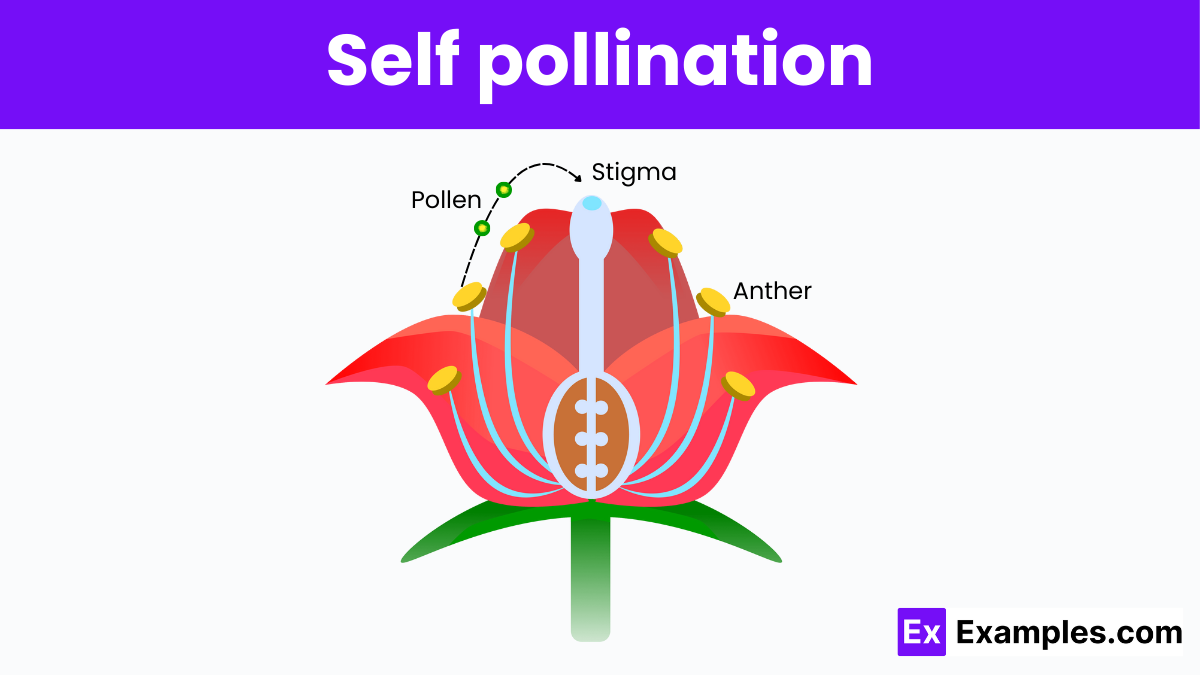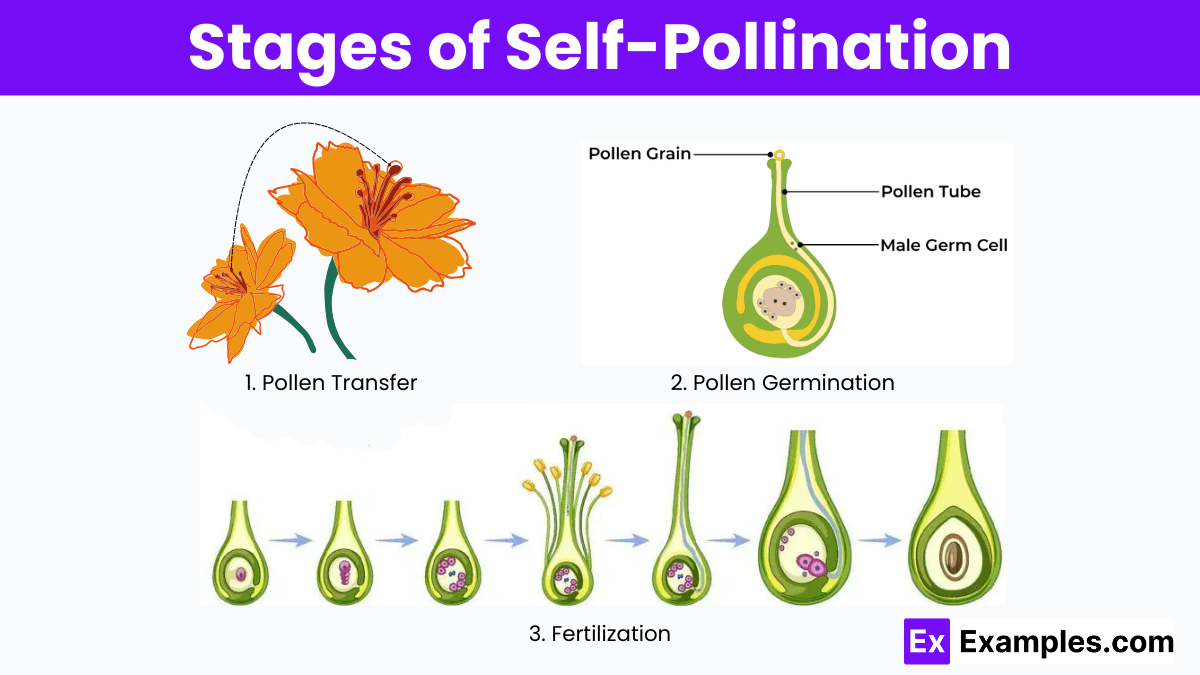Self-pollination occurs when pollen is transferred from the anther to the:
Stigma of another flower
Stigma of the same flower
Sepal of the same flower
Ovary of another flower

Self-pollination is a fascinating reproductive mechanism in plants where pollen from the same flower or different flowers of the same plant fertilizes the ovules. This process ensures that a plant can reproduce independently, without the need for external pollinators such as insects or wind. Self-pollination plays a crucial role in the survival and propagation of many plant species, especially those in isolated or stable environments where cross-pollination opportunities may be limited. It offers the advantage of preserving successful genetic traits but at the cost of reduced genetic diversity. In this introduction, we explore how self-pollination occurs and its implications for plant evolution and adaptation.
Self-pollination is a form of reproduction in plants where pollen from an anther of a flower lands on the stigma of the same flower or another flower on the same plant. This process enables a plant to fertilize itself without relying on external agents like insects, animals, or wind for the transfer of pollen.
Autogamy refers to the transfer of pollen from the anthers to the stigma of the same flower. This type of self-pollination ensures that a plant can reproduce independently, without the need for pollen to move between different flowers. It often occurs in plants with flowers that are capable of self-fertilizing without opening (cleistogamous flowers), which protects the reproductive process from environmental variables and maximizes the chances of successful pollination.
Geitonogamy involves the transfer of pollen from the anther of one flower to the stigma of another flower on the same individual plant. While this is technically a form of self-pollination because it does not introduce genetic material from another plant, it still requires some form of pollen transfer mechanism, such as wind or insects. Geitonogamy is similar to cross-pollination in its dependence on these agents but does not enhance genetic diversity since the pollen does not come from a different genetic individual.
Cleistogamy is a unique form of autogamy where flowers never open and self-pollinate internally. These closed flowers ensure that self-pollination occurs without any interference from the external environment. Many grass species, including some types of wheat and barley, exhibit cleistogamy, which guarantees reproduction without the need for pollinators and reduces the risk of hybridization, maintaining genetic purity.
Self-pollination in plants is a process where a plant’s pollen fertilizes its own ovules, allowing it to reproduce without the need for external pollinators. This process can occur within the same flower, or pollen may transfer to another flower on the same plant. Plants that self-pollinate often exhibit specific adaptations that enhance the likelihood of self-fertilization.
1. Flower Structure: Many self-pollinating plants have flowers designed to facilitate the easy transfer of pollen to the stigma. For example, the anthers and stigmas are positioned closely to increase the chances of pollen contact. Some flowers may even remain closed (cleistogamous), ensuring that only self-pollination occurs.
2. Reduced Reliance on Pollinators: Since these plants do not depend heavily on pollinators like bees, birds, or wind, they often have less conspicuous flowers. These flowers might not produce a strong scent or vibrant colors, as their primary focus is not to attract external pollinators.
3. Genetic Consistency: Self-pollination leads to a high degree of genetic similarity between parent plants and their offspring, preserving successful adaptations over generations. This consistency is crucial for plants in stable or isolated environments where specific traits provide an evolutionary advantage.
One of the most well-known examples of self-pollination occurs in the pea plant (Pisum sativum). Pea plants are frequently used to study genetic principles, famously by Gregor Mendel in his pioneering work on genetics. The structure and reproductive process of pea plants make them ideal for self-pollination.
Flower Structure: Pea plants produce flowers that are naturally adapted to self-pollinate. Typically, the petals of these flowers tightly enclose the reproductive parts, preventing other plants’ pollen from entering.
Pollination Mechanism: Inside these closed flowers, the anthers, which produce pollen, are positioned very close to or directly touch the stigma, the part of the flower that receives pollen. This proximity ensures that the anthers release pollen directly onto the stigma of the same flower.

Self-pollination is a form of pollination that occurs when pollen from the anther of a flower is deposited on the stigma of the same flower or another flower on the same plant. This process is common in plants that have mechanisms to facilitate or ensure pollination without the need for cross-pollination by other individuals, enhancing reproductive success in stable environments where cross-pollination partners are scarce.
The first stage involves transferring pollen grains from the anther to the stigma of the same plant. This transfer can occur within the same flower or to another flower on the same plant. In some species, the anther positions itself directly above the stigma, making self-pollination more likely due to proximity.
Once pollen grains land on a compatible stigma, they germinate. This means the pollen grain grows a pollen tube that extends down the style towards the ovary.
Through the pollen tube, sperm cells from the pollen grain travel to the ovary where they fertilize the ovules. This fertilization results in the formation of seeds.
Self-pollinating flowers are designed to fertilize themselves, often without the need for external pollinators. This characteristic is especially prevalent in certain types of plants, which have evolved specific features to promote self-pollination. Here are some common types of self-pollinating flowers:
These flowers never open and are therefore always self-pollinated. They are found in species like some violets and grasses. Cleistogamous flowers ensure reproductive success without dependence on pollinators and external environmental conditions.
Flowers of the pea plant are a classic example of self-pollinating species. They have a structure that naturally promotes self-pollination by positioning the stigma close to the anthers, allowing pollen transfer within the same flower.
Tomato flowers are equipped with structures that allow for easy self-pollination. The anthers form a cone around the stigma, trapping pollen to ensure it contacts the stigma without the need for wind or pollinators.
Beans, including species such as broad beans and runner beans, have flowers that facilitate self-pollination. The flowers are typically structured to optimize pollen transfer to the stigma of the same flower.
Wheat flowers are another example where self-pollination is predominant. The flowers are generally closed, which prevents pollen from other plants entering and encourages self-pollination.
Like wheat, barley flowers mostly self-pollinate. Their floral arrangement limits the exposure of the stigma and anthers to external pollinators, favoring self-pollination.
Meiosis is a fundamental process in sexual reproduction that results in the production of gametes with half the number of chromosomes of the parent cell. This reduction is crucial for maintaining the stability of the species’ chromosome number across generations when gametes fuse during fertilization. In the context of self-pollinating species, meiosis provides several long-term benefits despite the reduced genetic diversity typically associated with self-pollination:
Although self-pollination tends to decrease genetic variability, the process of meiosis can still introduce some level of genetic diversity. During meiosis, events such as crossing over (the exchange of genetic material between homologous chromosomes) and independent assortment (the random distribution of chromosomes to gametes) occur. These mechanisms can create new combinations of genes within the gametes of a single plant, even if the genes come from the same individual.
The genetic variation generated by meiosis can lead to new traits that might offer a selective advantage under changing environmental conditions. Even minimal changes can significantly impact the fitness of a population, allowing it to adapt and evolve over time. This potential for adaptation is crucial for the survival of species in dynamic ecosystems.
Over generations, the subtle genetic variations produced by meiosis can contribute to increased disease resistance. This is particularly important for self-pollinating species, as their reduced gene pool can make them more susceptible to pathogens if not for the occasional introduction of new genetic combinations that confer resistance.
Meiosis in self-pollinating plants stabilizes beneficial traits within a population. Since self-pollination typically results in offspring genetically similar to the parent, it likely preserves and maintains beneficial adaptations across generations, ensuring the continuity of traits well-suited to specific environments.
The regular occurrence of meiosis can also help in purging deleterious alleles from the population over time. The process of segregation and independent assortment during meiosis can lead to gametes that do not carry harmful mutations, gradually reducing their frequency in the population.
Self-pollination is a significant reproductive strategy in many plants, offering both benefits and drawbacks depending on the ecological and environmental context. Here’s an in-depth look at the advantages and disadvantages of this process:
Self-pollination occurs when a flower’s pollen fertilizes itself or another flower on the same plant, enabling reproduction without external pollen sources.
Common self-pollinating plants include tomatoes, peas, wheat, barley, chickpeas, and lettuce, each adapted to reliably produce seeds independently.
Self-pollination involves a single plant’s flowers fertilizing themselves, while cross-pollination occurs between flowers of different plants, enhancing genetic diversity.
To self-pollinate, gently shake or brush the flower to transfer pollen from the anthers to the stigma within the same flower or to another flower on the same plant.
Yes, you can pollinate a plant with itself either naturally through its flower structure or manually by transferring pollen to its own stigma to produce seeds.
Text prompt
Add Tone
10 Examples of Public speaking
20 Examples of Gas lighting
Self-pollination occurs when pollen is transferred from the anther to the:
Stigma of another flower
Stigma of the same flower
Sepal of the same flower
Ovary of another flower
Which type of plants are most likely to use self-pollination?
Dioecious plants
Monoecious plants
Cross-pollinated plants
Insect-pollinated plants
A key advantage of self-pollination is:
Genetic diversity
Reduced dependence on pollinators
Increased disease resistance
Higher seed variability
Which of the following is an example of a self-pollinating plant?
Apple
Wheat
Corn
Sunflower
Self-pollination can lead to:
Increased genetic variation
Decreased genetic variation
Higher plant diversity
Increased pollinator visits
Self-pollination primarily occurs in:
Only gymnosperms
Only angiosperms
Both gymnosperms and angiosperms
Only ferns
Self-pollination ensures:
Reproduction in isolated environments
Cross-breeding between different species
Increased susceptibility to diseases
Dependency on weather conditions
Which plant structure is directly involved in self-pollination?
Petal
Anther
Sepal
Peduncle
Which condition might favor self-pollination over cross-pollination?
High plant density
Low plant density
High genetic diversity
Abundant pollinators
Self-pollination is least likely to occur in plants with:
Perfect flowers
Imperfect flowers
Monoecious flowers
Bisexual flowers
Before you leave, take our quick quiz to enhance your learning!

